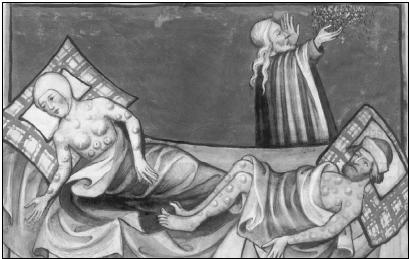But in the intervening 14th century, something occurred in Europe that had a huge impact upon all of European society and the ripples of which are still being felt—the Black Death. It originally struck Europe during the Dark Ages in the 6th century and was called the “Justinian Plague” but not much is known of how it traveled or how it ended. The disease struck Europe again in 1347 and killed a third of Europe’s population. Much better documented, we know this second wave had its genesis in China. The bacterium responsible was
Yersinia pestis which preferred to infect such rodents as rats, mice, marmots and voles—all of which are found in great abundance in China. The bacterium actually did not naturally attack humans but contact came through a vector—the flea. The fleas bit the rodents, contracted the bacteria, jumped off the rodent host and onto a human and bit them thereby transmitting the bacteria to human hosts. Symptoms manifested in two to five days and the stricken person fell ill and died within four days after showing symptoms. The disease came to Europe via Venetian traders who came in contact with it while traveling the Silk Road.
Symptoms consisted of high fever, severe muscle cramps, chills, seizures, extreme fatigue, delirium, coma and hematemesis (vomiting of blood). The stricken person presented a shocking spectacle due to acral gangrene which resulted in a horrid blackening of the fingers, toes, nose and lips (ecchymoses) caused by blood seeping into the tissues from ruptured blood vessels. Essentially, the flesh is decomposing while the person is alive which causes extreme pain and discomfort (as though someone is holding a blow torch to the affected area). The bacteria bred in the lymph nodes causing them to swell considerably and so lumps called buboes (hence the term “bubonic”) appeared on the groin, armpits and neck. The appearance of the buboes is ghastly and alarming. These are coupled with ugly black spots that cover the body called lenticulae.
To make matters worse, the Black Death wasn’t one disease but two: plague and cholera together. Cholera is a disease of the small intestine cause by a bacterium called Vibrio cholerae. It is caused by the introduction of fecal matter into the body from an infected host. Usually, this is transmitted via the drinking of fecal-contaminated water or the eating of shellfish harvested from such water. The bacteria that survive the journey through the stomach then bore through the mucous membrane of the small intestine and lodges in the lining where it multiplies and releases toxic proteins that cause a very runny, fishy-smelling diarrhea called “rice water” (guess why) as well as vomiting. If not treated, cholera will afflict a stricken person with sunken eyes and shriveled, wrinkled, bluish-gray skin due to acute dehydration. Today, it is treated fairly easily and with great success but in medieval Europe, it was far deadlier (it was actually known as “the Blue Death”) especially in conjunction with bubonic plague. A stricken person had no chance. The only merciful thing about the Black Death was that an afflicted person died fairly quickly albeit in agony.

A mannequin showing what Black Death victims looked like. Actually, as bad as this looks, it is not as bad as a real victim looks. The nose and lips are usually black and the buboes are quite a bit more disgusting. With proper treatment, people who contract the plague can recover from it, even from the ecchymotic necrosis. Imagine what it must have been like to helplessly watch loved ones, family members and neighbors suffer and die of this disease. Imagine having to check your body everyday for buboes knowing if you found any, you had just days to live. Imagine there being almost no place to run from it since it was afflicting people all over Europe and Eurasia. Everywhere you go, you see people carrying and carting bodies through the streets. Not a single household was unaffected.

A stricken man discovers buboes in his armpit while a physician discovers buboes on a woman’s neck. The Black Death struck and killed young and old, male and female indiscriminately.

Husband and wife dying of the Black Death while a physician attempts to affect a remedy. People actually thought drawing crosses on their doors would ward off the disease. Needless to say, it didn’t.

Venice 1349.

The plague doctor wore a long robe and gloves, high boots, tight-fitting hat and a mask to shield him from direct contact with infected persons. The mask had a long snout because it contained various herbs and flower petals to filter and mask the stench which was believed to cause a person to get infected. To the medieval people, the Black Death was a type of malaria or “bad air.” Since they had no idea of what caused the disease and therefore no effective treatment, the plague doctors also contracted the disease and died.